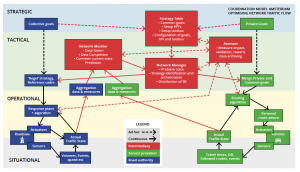The public and private partners in the European project SOCRATES develop and test various smart traffic information and navigation services for road users, such as optimized navigation advice at major events and road works. The challenge is not only the technical realization of the services but also lies in the cooperation.
Cooperation models
In order to shape the cooperation, six cooperation models have been developed, in which the role of the so-called ‘Intermediary’ as a completely new function is implemented.
Based on a shared vision, the partners in SOCRATES2.0 have developed a theoretical framework for public-private cooperation in traffic management. In this phase of the project, the partners covered the tactical level of cooperation by specifying the framework for four pilots.
The framework describes various cooperation models, from simple to very complex. The more complex the cooperation, the more intermediary roles have to be implemented.
The so-called ‘Intermediary’ consists of a maximum of four clusters of tasks:
The Strategy Table
The Strategy Table provides the frameworks and preconditions and the toolbox to be used for interactive traffic management in the form of a network vision, associated KPIs and traffic management and information services to be applied. The table is provided as a consultation structure, where the actual staffing consists of representatives of public and private partners.
The Network Monitor
On the basis of all available data, the network monitor develops the best picture of the current traffic situation (current common truth) and a short-term traffic forecast (predicted common truth). For this purpose, data is collected, tested for quality, fused and completed. The best picture of the current and expected traffic situation is used to determine the set of measures proposed by the Network Manager to road authorities and service providers (so-called service requests).
The Network Manager
The task of the Network Manager is – with input from the Network Monitor and according to the agreements made in the Strategy Table – to determine the most suitable services at that time and to make service requests for this to both the traffic centers and the service providers. It is foreseen that the tasks of the Network Manager are automated as much as possible, with regular monitoring of the functioning.
The Assessor
The Assessor monitors whether the service requests have actually been converted into the actual deployment of the requested services by the parties and assesses the impact of these measures. In the case of cooperation based on an impact-driven earnings model, the Assessor also determines the valuation of the impact.
Complexity of cooperation
The complexity of the cooperation is determined by the level of detail of the information that is shared, the level of commonality in interpreting the data and the degree of coordination in giving traffic information and navigation advice. For example, sharing information on the location and validity of environmental zones is easier to access than sharing tactical and strategic information about, for example, unwanted diversion routes or (for private parties) the number of users of a navigation service in a certain area at a given time. The cooperation becomes more complex when information is jointly interpreted and traffic information and navigation advice are implemented in a coordinated manner.
In the coming months, the adjustments to both systems (in traffic management centers and back offices of technical service providers) and products (apps and onboard navigation) will be prepared. In the run-up to the Summer, users will be recruited to participate in the pilots. The first pilots are expected to start in the Summer.
Source: SOCRATES2.0

